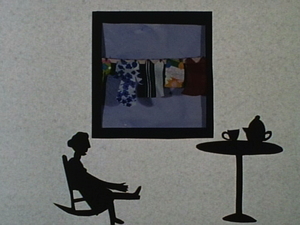Ann Arbor Film Festival, Day 1: Variety and creativity return in opening screenings
Tian-Jun Gu and Greg Wachtenheim, both students in the University of Michigan's screenwriting program, are blogging for AnnArbor.com from the 49th Ann Arbor Film Festival, which got under way last night. This is their first report.
The Ann Arbor Film Festival is in its 49th year and during the introduction ceremony, Donald Harrison, festival executive director, took a moment to note that the festival was approaching the half-century mark: a truly significant milestone for the longest-running independent and experimental film festival in North America.
The festival began with "Ray’s Birds" (Deborah Stratman, 2010). Stratman documents a bird conservation center in Northumberland, England, where Ray Lowden keeps birds of prey ranging from buzzards to European eagle owls and hopes to reintroduce them into the wild. Lowden’s passion for bird conservation began at the age of 14 and has continued on for over 40 years. The film ends with a shot of a handful of small birds taking off as Lowden approaches them. It is a quietly joyous reminder that even though the birds are not destined to stay at the center, it is nevertheless a place they can call home.
"Il Capo" (Yuri Ancarani, 2010) focuses on a marble quarry in Carrara, Italy. Ancarani contrasts the quarrymen and their machines with the rustic beauty of the Apuane Alps, thus providing a dialogue on the tense relationship between man and nature.
"Sleep" (2010), an animated short created by filmmakers Claudius Gentinetta & Frank Braun, takes the ordinarily monotonous pattern of human snoring and uses it to shape a visually engaging and humorous narrative. The initial soft breathing is matched to a soothing, undulating wave. As the snore becomes harsher, a monstrous ocean-liner emerges from the waves. With each exhale, a comical puff of smoke floats from the ship’s smokestacks. In the film’s climax, the ocean-liner and its inhabitants sink and are tossed by the destructive waves. In the denouement, the breathing returns to its initial lull, and the untamed tide recedes to soothing and calm waves once again.
Gina Kamentsky’s "House Bunny" (2010) showcases a painstaking and visually stunning animation technique. Kamentsky gathered hundreds of feet of movie trailers, bleached off parts of the emulsion, leaving fragments of the trailers behind, and then animated over the bleached emulsion. The delightful blend of animation and film is matched to jazz music so as to create a visual representation of sound out of recycled film footage.
Chichiro Amemiya’s documentary "Grandpa’s Wet Dream" (2010) centers on Shigeo Toduka, a 75-year-old man living in Japan, who, unbeknownst to his wife and kids, has been acting in adult films for fifteen years. Though this film maintains a comic tone and elicited a number of laughs from the audience, it simultaneously nurtures more serious undertones. Prompted by an interviewer, Tokuda discusses how he would feel if his videos were to be aired in front of his mourners at his wake. Tokuda claims he is proud of the work he has done, and would not regret if his films were shown to his mourners. While Tokuda is conflicted about his decision to participate in pornography, he has a strong desire to lead an interesting life and leave a unique legacy after his death. With its selection of this film, the AAFF shows its penchant for deviating from the norms, a tendency which has bolstered its unique standing in the film community.
"Sharp Edge Blunt" (Leighton Pierce, 2010) presents a fun subversion of audience expectations as a blade is sharpened for unknown purposes. It is then dulled and used to slice a pomegranate.

"The Florestine Collection"
"The Florestine Collection" (Helen Hill & Paul Gailiunas, 2010) concluded the opening night screenings. Originally, this was a tale of the African-American seamstress who had made the hundred handmade dresses Hill found in a trash pile on one Mardi Gras Day in New Orleans. The dresses and film footage were then flood-damaged by Hurricane Katrina. In 2007, Hill, sadly, was murdered during a home invasion before she could finish the film. Her husband, Gailiunas, completed it. The film, told through a mixture of animation and live-action footage, conveys its themes of rebuilding and improvement on both a social and profoundly personal level.
After the screenings, Donald Harrison mediated a Q & A session with Deborah Stratman and Paul Gailiunas. Stratman and Gailiunas answered questions regarding their filmmaking processes and future projects. Following the Q & A, attendees were invited to an after-party at Sava’s.
The festival stayed true to its founding spirit and judging by the audience reaction, it was a resounding success. So bring on the 50th year because with this sort of positive response, the AAFF and audiences can look forward to the next 50 years and beyond.


Comments
Josh T
Thu, Mar 24, 2011 : 2:27 p.m.
"Il Capo" was a beautiful short! The shots were amazing and the quarryman looked like a conductor to a symphony of machines.
Moose
Thu, Mar 24, 2011 : 5:57 a.m.
Return to variety and creativity? When did they leave the AAFF? How many years have the writers been attending to make that claim?